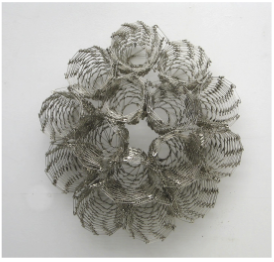It happened to be...…
Tamiko Kawata was born female in Kobe, Japan, in 1936, and grew up in Tokyo from the age of five.
She chose…
to become an artist,
to live in New York City in 1962,
and to become an American citizen in 2004.
Through her artwork, Kawata searches for another vision and way of thinking about life, navigating the space between installation, sculpture, and wall works. For over forty years, she has used overlooked objects from daily life as her primary media. Discarded materials hold importance for her not only because of environmental concerns but also as reflections of her own life. Her choice of materials and interpretations are shaped by the cultural contrasts she experiences between America and Japan, where she was raised. Often employing repetition, she seeks to create energy and chaos within quiet stillness.
As critic Seth Rodney wrote in Hyperallergic, “[Kawata] works with meticulous manipulation of unassuming everyday materials that entered her new life [in America]. At the same time her work is a rigorously modernist practice that walks the bridge between the 1960’s and now.”
The philosophies of Bauhaus and Dadaism spoke deeply to the wounded youth of post–World War II Japan, and Kawata was no exception. She learned from and observed the Gutai Group during her formative years. Her seventy-foot-long safety pin sculpture, Serpent, wraps sinuously around a tree like a living Gutai gesture. At the same time, the Bauhaus curriculum she studied provided a solid foundation for her creative philosophy and artistic process.
Now, as she enters the later phase of her life, Kawata continues to yearn to create both large- and small-scale works that will leave a lasting presence. She has produced more than thirty maquettes—some intended to be enlarged and fabricated in permanent, recycled materials—so that viewers may physically walk through them.
The encounter with a new culture upon arriving in America left a profound and lasting impact on her. Much of her work remains a response to that initial impression—an ongoing dialogue between memory, material, and place.



